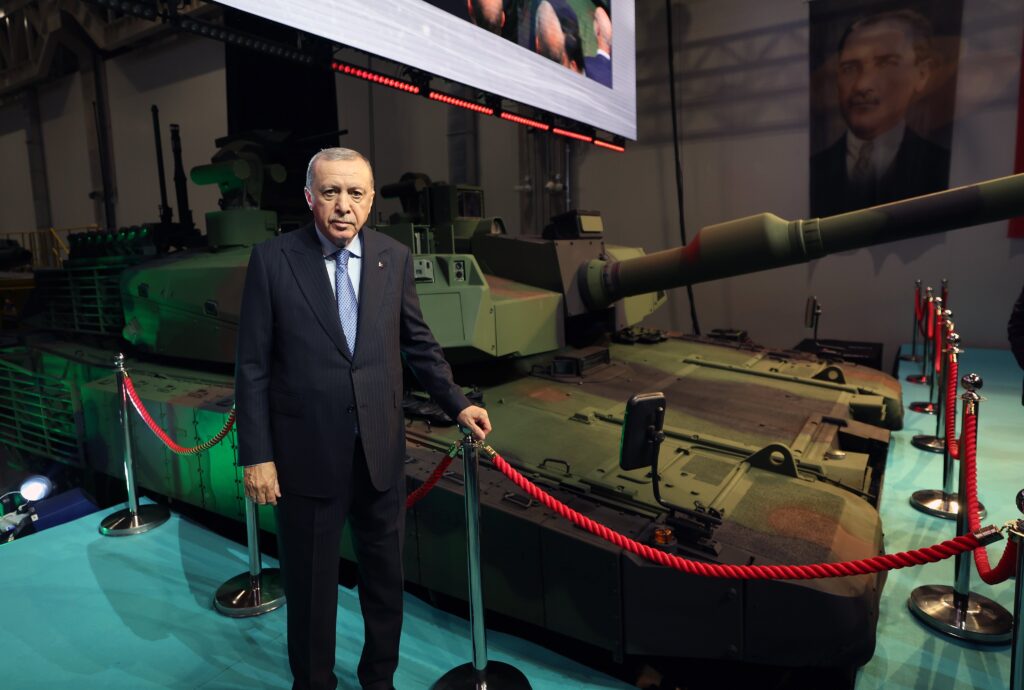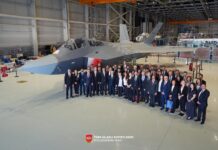Türkiye has officially begun serial production of its indigenous Altay main battle tank (MBT). The first two units were delivered to the Turkish Land Forces during the opening of BMC’s new Tank And New-Generation Armoured Vehicle Production Facility in Ankara on 28 October 2025 during a ceremony attended by Turkish Presiden Recep Tayyip Erdoğan.
BMC’s Ankara production complex was designed on a 100-hectare campus and consists of two main facilities: the BMC Power Plant and the BMC Ankara Tank and New Generation Armored Vehicle Production Facility. The BMC Power facility was completed and operational last year, producing engines and transmissions for Altay MBTs, Fırtına self-propelled howitzers, other next-generation armoured vehicles and naval platforms. It currently produces domestic engines ranging from 400 hp to 600 hp and powerpacks rated from 1,000 hp to 1,500 hp.
The newly inaugurated armoured vehicle facility will produce both tracked and wheeled vehicles, including the Altay MBT and Altuğ 8×8 armoured vehicle family. The complex also features a 30-hectare test area for evaluating vehicles under various terrain conditions, equipped with world-class testing facilities. In addition, an integrated logistics and training centre is located within the facility. Once fully operational, the complex will employ approximately 1,500 engineers and technicians.
According to BMC Chairman Fuat Tosyalı, who spoke at the opening ceremony, the new facility is designed for a monthly output of eight Altay MBTs and around t10 Altuğ armoured vehicles, thanks to modular production lines that can be reconfigured for different platforms.
The Altay’s development and qualification phase comprised over 1.5 million engineering hours, 35,000 km of mobility trials and 3,700 live-fire tests, according to official figures. The tank weighs 65 tonnes and reaches speeds of 65 km/h on roads and 45 km/h off-road.
Major Turkish defence firms Aselsan, Havelsan, Roketsan, and MKE are key subcontractors.
The Altay is fitted with a 120 mm L55 smoothbore gun produced by state-owned MKE. This is a chrome-plated smoothbore gun with a barrel length of 6.6 m, a barrel weight of around 1,324 kg and an overall weapon system weight in the 3,100 kg range. Its listed practical firing rate is approximately six rounds per minute, while its effective direct-fire engagement range depends on ammunition type, with the range of an armour–piercing fin-stabilised discarding-sabot round likely reaching 4 km. Secondary weapons include a coaxial 7.62 mm machine gun and a remote-controlled weapon station (RCWS) capable of mounting either a 12.7 mm or 7.62 mm machine gun.

Additional systems include the driver vision system, turret slip ring unit, LIAS-400 laser warning system, and the Akkor-100 active protection system, which provides automated defence against incoming anti-tank missiles. The Batur 100 battle management and information system integrates the tank within the broader tactical network, while the Identıffy BTID900 battlefield identification system ensures secure friend-or-foe recognition. These systems form the core of the Altay’s electronic and protective architecture, significantly increasing its combat effectiveness and crew survivability.
Roketsan developed the Altay’s modular composite armour package, designed to provide multi-hit protection against kinetic and chemical energy threats. The armour uses advanced layered materials optimised for both weight and ballistic resistance, with adaptable panels for future upgrades.
Havelsan is delivering a comprehensive tank training ecosystem, combining virtual, augmented and physical simulation environments. This includes a virtual maintenance and fault simulation system, semi-open mock-ups and a live turret training model featuring real turret and hull components with a domestically produced motion system. The company will provide 94 training products across 44 product types in 10 batches, with the first deliveries expected by late 2025.
The Altay MBT programme is structured in three planned blocks: T1, T2 and T3. The initial T1 batch (85 tanks) uses a South Korean powerpack, consisting of the Doosan DV27K V12 diesel engine and the SNT Dynamics EST15K automatic transmission. The DV27K is a 12-cylinder, 27.2-litre engine rated at 1,500 hp, while the EST15K transmission features a hydraulic torque converter and provides six forward and three reverse gears.
From the T2 variant onward, the Altay will transition to the indigenous Batu powerpack developed by BMC Power. The integration of the Batu into serial production tanks is planned to commence in 2028. The Batu powerpack includes a V12 water-cooled, turbocharged diesel engine delivering a minimum of 1,500 hp. The automatic transmission will feature six forward and two reverse gears along with steering and braking functions.
The T3 variant, still under conceptual development, is expected to introduce an unmanned turret and additional automation features, reflecting the next phase in Türkiye’s armoured vehicle modernisation roadmap.










![Danish acquisition programmes Danish soldiers training in Kangerlussuaq, Greenland, during June 2025. [Forsvaret/Rebekka Gimm]](https://euro-sd.com/wp-content/uploads/2025/07/Danish-Soldiers-in-Greenland-Kopie-218x150.jpg)

![The long road to Altay The ‘Yeni Altay’ (ENG: New Altay) pictured here is understood to represent the serial production version of the Altay T1. [BMC Otomotiv]](https://euro-sd.com/wp-content/uploads/2025/07/Image_11-Kopie-218x150.jpg)
![Key programmes bolster Türkiye’s defence-export boom Secretary of the SSB, Prof. Dr. Haluk Görgün, said that Türkiye was building a “ground-breaking ecosystem in technology exports for the future”. [TiM]](https://euro-sd.com/wp-content/uploads/2025/07/2-Prof-Dr-Haluk-Gorgun-Jan-2025-Credit-TiM-Kopie-218x150.jpg)
